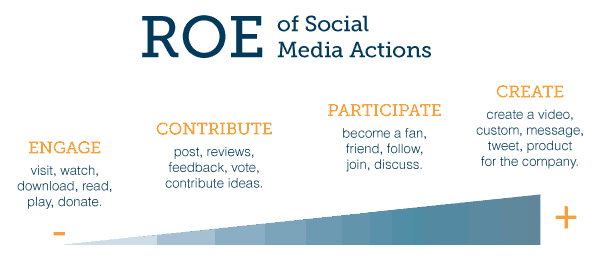I touched on Return on Engagement (ROE) in my first post and thought it would only be fair to explain a bit what ROE is and how it is helpful for your Social Media strategy.
I cannot explain ROE without a bit if background into traditional marketing measurements first. In this article I will mostly be talking about Facebook as the media platform. CRM is another game altogether.
Return on Investment (ROI)

In Digital Marketing one of the key focus areas is Return on Investment. This is pretty standard and makes sense. You surely want to see how well your media is doing. In layman’s terms the return is the money you make from a campaign, and the investment is the money you spend on agency fees, display advertising etc. or simply put: cost. But this cannot be the only measurement since there are usually other channels involved and with the very way the social web works people share information very freely and quickly.
Additionally depending on the buying cycle of the product you are selling the consideration phase for purchase can be particularly hard to measure effectively. You want to attract fans/customers from all stages of the customer lifecycle. Social Media sows the seeds for future purchase.
Marketing Channel Shift
With the evolution of Social Media, the traditional marketing channels have changed. Whilst TV advertising and print still have their place the audience has shifted. It is younger, more tech savvy and knowledgeable thanks to the desire to learn about things and share experiences.
Brands have had a great opportunity to put themselves in the faces of their customers for practically no cost. Facebook, Twitter, Google+ and others are all still very young and trying to find their best monetization methods for their respective platforms.
With this shift new considerations are needed.
Return on Engagement (ROE)

While you may not be able to put an actual price on the return of your social efforts easily there are some key metrics that you can take in to use right away. Many people have been suckered by “likes” on Facebook, but does it add any insight into how you are interacting with your audience? Simple answer: no!
So what do you look for if likes aren’t a true representative of your presences. Engagement on your page. Look at the activities around your “posts or tweets”, not just the fan page itself. Look for (on a post level):
- Like
- Shares
- Comments or replies (including sentiment)
From a Twitter perspective there are a couple of measures, simply capturing retweets, replies or times the tweet has been favorited are pretty straightforward to get. The main thing here, I notice, is the different purposes of the social media platforms. Twitter to me has always been about peers and getting good information and links to great content from respected individuals from the community. I don’t follow Coke or Nike, for example, but I may well have liked them in Facebook – again that doesn’t mean that I see everything or anything they post though 🙂
Create yourself a weighting system to give more meaning to the interactions. For example a “like” is minimum, it takes very little effort. A “share” requires more effort since you then need to select a target audience (your wall or a friends) and perhaps write additional comments. Actual comments on the page are the most engaged since they require most effort. However, sharing to me at least, should be given equal weight since it’s getting your word out … for free. Word of Mouth is a great facet. It builds trust and credibility.
You may also want to add weight to the individuals who are more interactive. There are many influencers out there that can really help your business. On the other end of the scale, detractors can bring you down to earth very quickly. Capturing sentiment in the users interactions is a must also.
In coming articles I will share more thoughts on this and ways to actual see your ROE from your Social Media offering.
